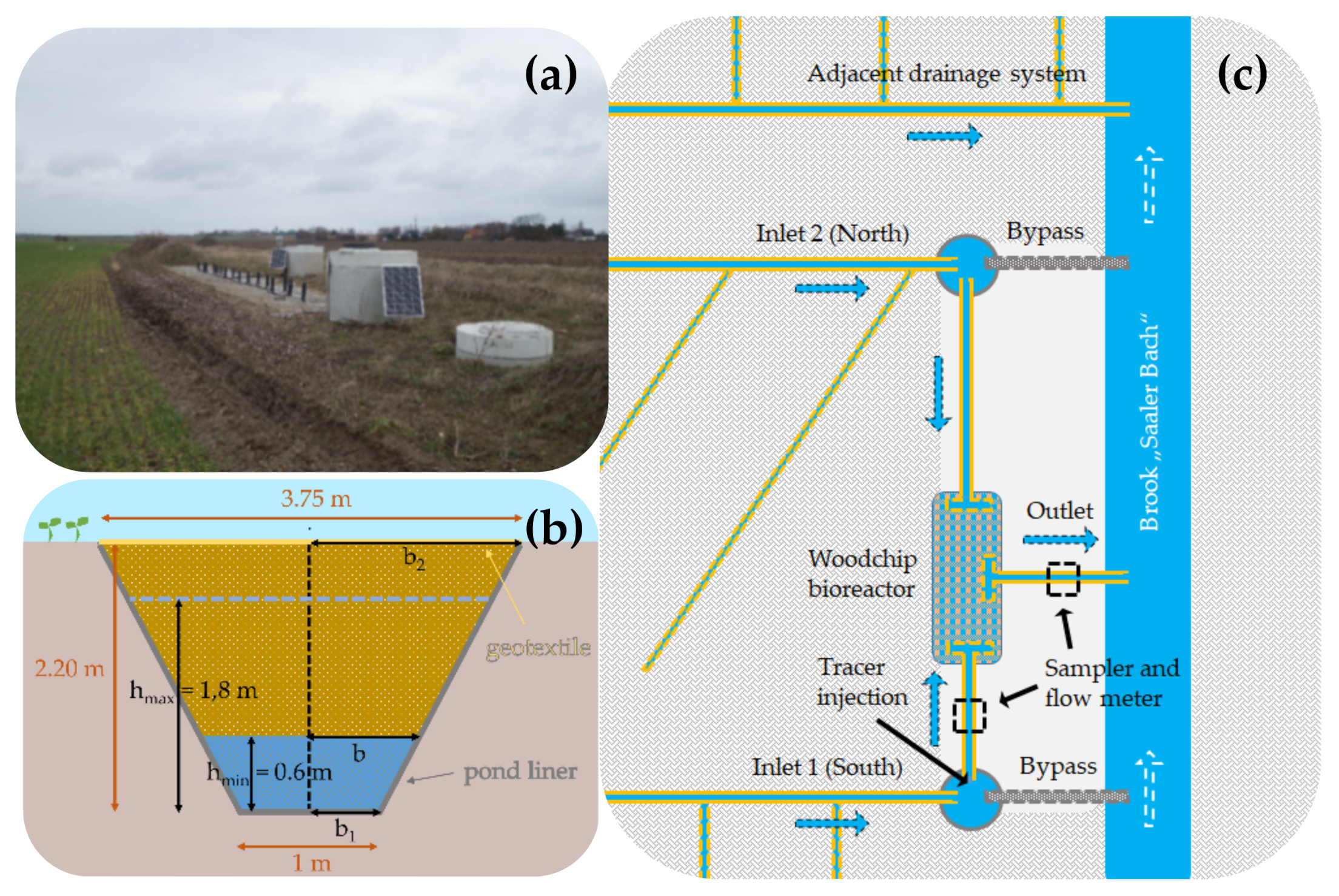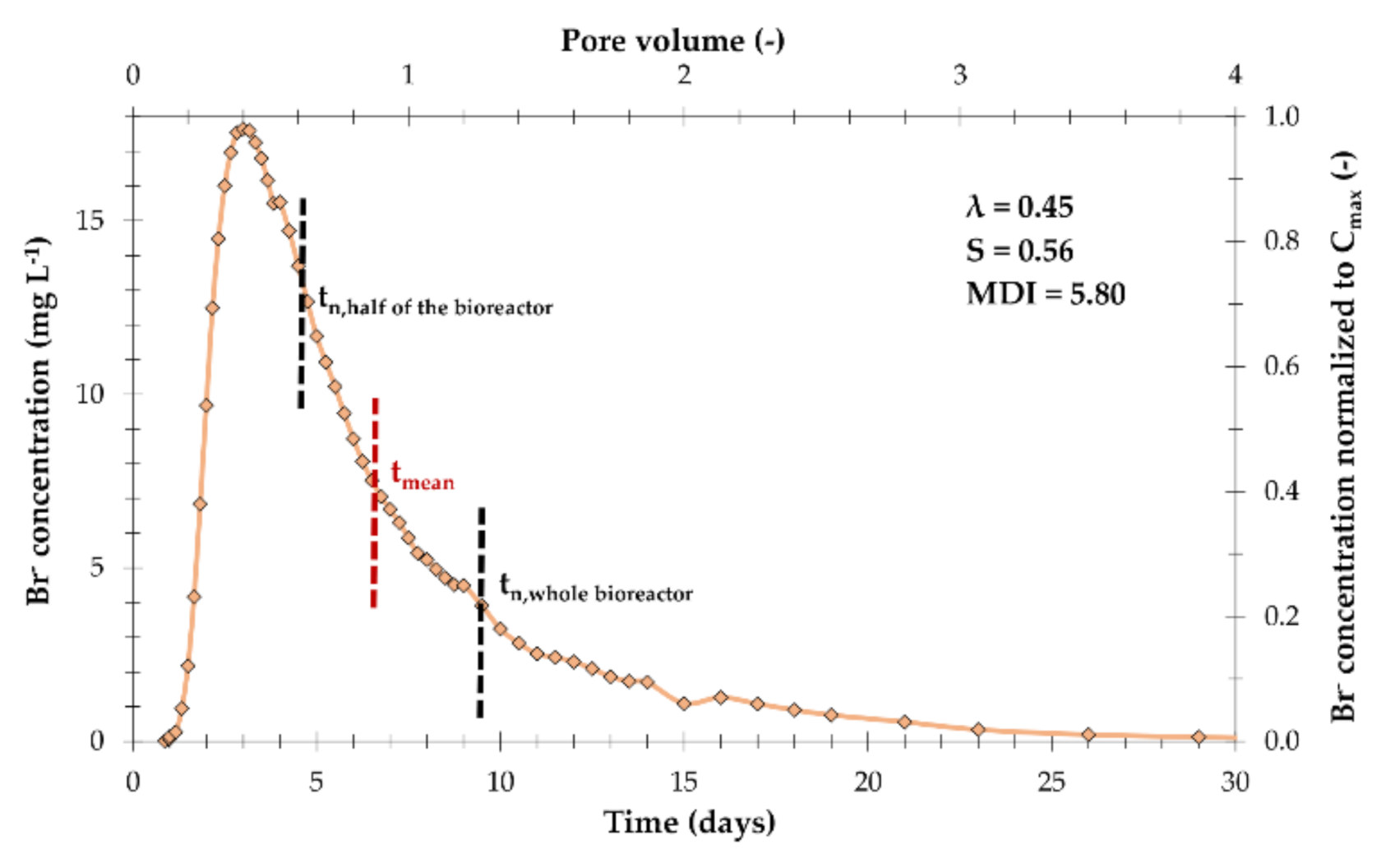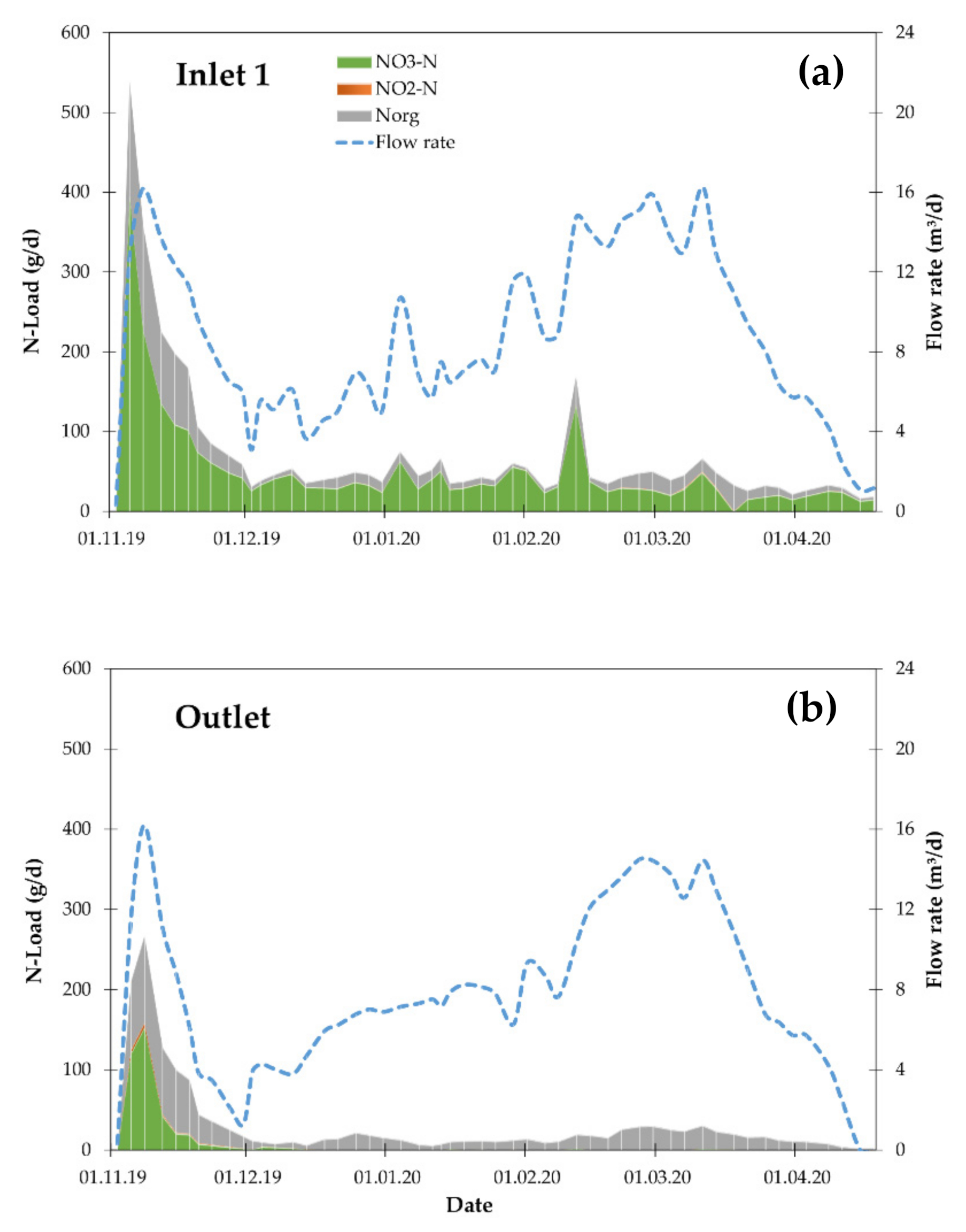Performance of a Woodchip Bioreactor for the Treatment of Nitrate-Laden Agricultural Drainage Water in Northeastern Germany
Abstract
:1. Introduction
2. Materials and Methods
3. Results and Discussion
3.1. Hydraulic Conditions in the Woodchip Bioreactor
3.2. Impact of the Woodchip Bioreactor on Nutrient Loads (N, o-PO4-P, OC)
4. Conclusions
Author Contributions
Funding
Acknowledgments
Conflicts of Interest
References
- Carpenter, S.R.; Caraco, N.F.; Correll, D.L.; Howarth, R.W.; Sharpley, A.N.; Smith, V.H. Nonpoint pollution of surface waters with phosphorus and nitrogen. Ecol. Appl. 1998, 8, 559–568. [Google Scholar] [CrossRef]
- Howarth, R.W.; Sharpley, A.; Walker, D. Sources of nutrient pollution to coastal waters in the United States: Implications for achieving coastal water quality goals. Estuaries 2002, 25, 656–676. [Google Scholar] [CrossRef]
- Bauwe, A.; Kahle, P.; Tiemeyer, B.; Lennartz, B. Hydrology is the key factor for nitrogen export from tile-drained catchments under consistent land-management. Environ. Res. Lett. 2020. [Google Scholar] [CrossRef]
- Kovacic, D.A.; David, M.B.; Gentry, L.E.; Starks, K.M.; Cooke, R.A. Effectiveness of Constructed Wetlands in Reducing Nitrogen and Phosphorus Export from Agricultural Tile Drainage. J. Environ. Qual. 2000, 29, 1262–1274. [Google Scholar] [CrossRef] [Green Version]
- David, M.B.; Gentry, L.E.; Cooke, R.A.; Herbstritt, S.M. Temperature and Substrate Control Woodchip Bioreactor Performance in Reducing Tile Nitrate Loads in East-Central Illinois. J. Environ. Qual. 2016, 45, 822–829. [Google Scholar] [CrossRef] [PubMed] [Green Version]
- Hoover, N.L.; Bhandari, A.; Soupir, M.L.; Moorman, T.B. Woodchip Denitrification Bioreactors: Impact of Temperature and Hydraulic Retention Time on Nitrate Removal. J. Environ. Qual. 2016, 45, 803–812. [Google Scholar] [CrossRef] [PubMed] [Green Version]
- Christianson, L.E.; Bhandari, A.; Helmers, M.J.; Kult, K.J.; Sutphin, T. Performance Evaluation of Four Field-Scale Agricultural Drainage Denitrification Bioreactors in Iowa. Trans. Asabe 2012, 55, 2163–2174. [Google Scholar] [CrossRef] [Green Version]
- Kleimeier, C.; Liu, H.; Rezanezhad, F.; Lennartz, B. Nitrate Attenuation in Degraded Peat Soil-Based Constructed Wetlands. Water 2018, 10, 355. [Google Scholar] [CrossRef] [Green Version]
- Rivett, M.O.; Buss, S.R.; Morgan, P.; Smith, J.W.N.; Bemment, C.D. Nitrate attenuation in groundwater: A review of biogeochemical controlling processes. Water Res. 2008, 42, 4215–4232. [Google Scholar] [CrossRef] [PubMed]
- Christianson, L.; Helmers, M.; Bhandari, A.; Moorman, T. Internal hydraulics of an agricultural drainage denitrification bioreactor. Ecol. Eng. 2013, 52, 298–307. [Google Scholar] [CrossRef] [Green Version]
- Ghane, E.; Feyereisen, G.W.; Rosen, C.J. Efficacy of bromide tracers for evaluating the hydraulics of denitrification beds treating agricultural drainage water. J. Hydrol. 2019, 574, 129–137. [Google Scholar] [CrossRef]
- Christianson, L.; Christianson, R.; Helmers, M.; Pederson, C.; Bhandari, A. Modeling and Calibration of Drainage Denitrification Bioreactor Design Criteria. J. Irrig. Drain. Eng. 2013, 139, 699–709. [Google Scholar] [CrossRef]
- Christianson, L.; Castelló, A.; Christianson, R.; Helmers, M.; Bhandari, A. Technical Note: Hydraulic Property Determination of Denitrifying Bioreactor Fill Media. Appl. Eng. Agric. 2010, 26, 849–854. [Google Scholar] [CrossRef]
- Headley, T.R.; Kadlec, R.H. Conducting hydraulic tracer studies of constructed wetlands: A practical guide. Ecohydrol. Hydrobiol. 2007, 7, 269–282. [Google Scholar] [CrossRef]
- Hillel, D. Environmental Soil Physics; AP Academic Press: San Diego, CA, USA, 1998; ISBN 9780123485250. [Google Scholar]
- Metcalf and Eddy Inc. Wastewater Engineering. Treatment and Resource Recovery, 5th ed.; McGraw-Hill: New York, NY, USA, 2014; ISBN 9781259010798. [Google Scholar]
- Christianson, L.; Feyereisen, G.W.; Hay, C.; Tschirner, U.W.; Kult, K.; Wickramarathne, N.M.; Hoover, N.; Soupir, M.L. Denitrifying Bioreactor Woodchip Recharge: Media Properties after Nine Years. Trans. ASABE 2020, 63, 407–416. [Google Scholar] [CrossRef]
- Welander, U.; Mattiasson, B. Denitrification at low temperatures using a suspended carrier biofilm process. Water Res. 2003, 37, 2394–2398. [Google Scholar] [CrossRef]
- Feyereisen, G.W.; Moorman, T.B.; Christianson, L.E.; Venterea, R.T.; Coulter, J.A.; Tschirner, U.W. Performance of Agricultural Residue Media in Laboratory Denitrifying Bioreactors at Low Temperatures. J. Environ. Qual. 2016, 45, 779–787. [Google Scholar] [CrossRef] [PubMed]
- Hao, Z.; Sun, M.; Ducoste, J.J.; Benson, C.H.; Luettich, S.; Castaldi, M.J.; Barlaz, M.A. Heat Generation and Accumulation in Municipal Solid Waste Landfills. Environ. Sci. Technol. 2017, 51, 12434–12442. [Google Scholar] [CrossRef] [PubMed]
- Soupir, M.L.; Hoover, N.L.; Moorman, T.B.; Law, J.Y.; Bearson, B.L. Impact of temperature and hydraulic retention time on pathogen and nutrient removal in woodchip bioreactors. Ecol. Eng. 2018, 112, 153–157. [Google Scholar] [CrossRef] [Green Version]





| Parameter | 2017/2018 | 2018/2019 | 2019/2020 |
|---|---|---|---|
| Air temperature (°C) | 3.1 | 4.8 | 5.3 |
| Water temperature (°C) | 4.9 | 10.3 | 7.1 |
| Redox potential E0 at inlet 1 (mV) | +145 | +286 | +190 |
| Redox potential E0 at inlet 2 (mV) | −185 | −137 | −204 |
| Hydraulic retention time tn (d) | 3.2 | 3.8 | 3.1 |
| NO3−-N in inflow (mg L−1) | 15.1 | 16.3 | 5.8 |
| NO3−-N in outflow (mg L−1) | 1.0 | 3.5 | 0.5 |
| NO3−-N removal rate (g m−3 d−1) | 2.31 | 0.78 | 0.75 |
| NO3−-N removal efficiency (%) | 90.2 | 51.0 | 84.8 |
| NO3−-N in outflow (g) | 2099.9 | 1132.1 | 1229.4 |
| (percentage of inflow) | (9.8%) | (49.0%) | (15.2%) |
| NO2−-N in outflow (g) | 2385.0 | 50.3 | 57.3 |
| (percentage of inflow) | (854.6%) | (136.0%) | (189.8%) |
| TNb in outflow (g) | No data | 1234.8 | 4651.5 |
| (percentage of inflow) | (50.3%) | (41.9%) | |
| PO43−-P in outflow (g) | 419.8 | 0.5 | 16.8 |
| (percentage of inflow) | (530.2%) | (34.4%) | (17.3%) |
| TOC in outflow (g) | 36,786.6 | 5676.5 | 39,840.1 |
| (percentage of inflow) | (197.8%) | (169.7%) | (145.6%) |
© 2020 by the authors. Licensee MDPI, Basel, Switzerland. This article is an open access article distributed under the terms and conditions of the Creative Commons Attribution (CC BY) license (http://creativecommons.org/licenses/by/4.0/).
Share and Cite
Gosch, L.; Liu, H.; Lennartz, B. Performance of a Woodchip Bioreactor for the Treatment of Nitrate-Laden Agricultural Drainage Water in Northeastern Germany. Environments 2020, 7, 71. https://doi.org/10.3390/environments7090071
Gosch L, Liu H, Lennartz B. Performance of a Woodchip Bioreactor for the Treatment of Nitrate-Laden Agricultural Drainage Water in Northeastern Germany. Environments. 2020; 7(9):71. https://doi.org/10.3390/environments7090071
Chicago/Turabian StyleGosch, Lennart, Haojie Liu, and Bernd Lennartz. 2020. "Performance of a Woodchip Bioreactor for the Treatment of Nitrate-Laden Agricultural Drainage Water in Northeastern Germany" Environments 7, no. 9: 71. https://doi.org/10.3390/environments7090071





